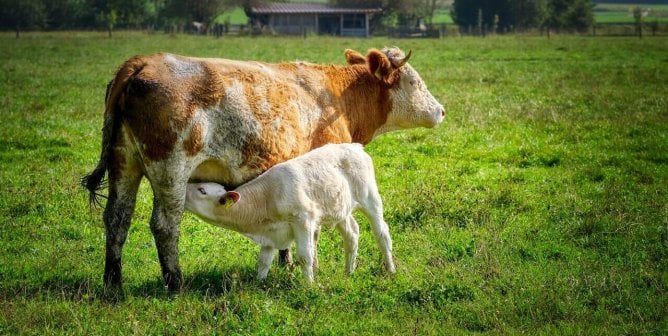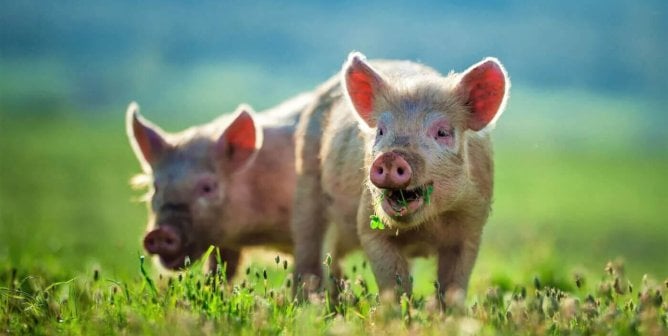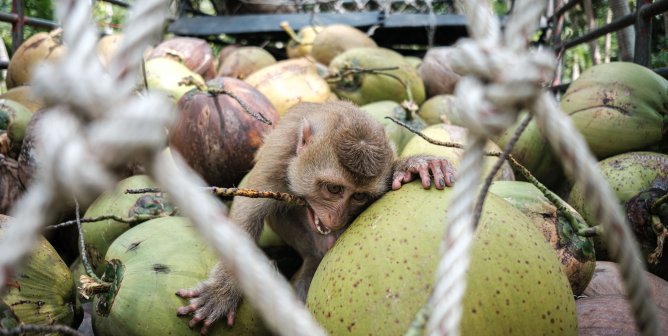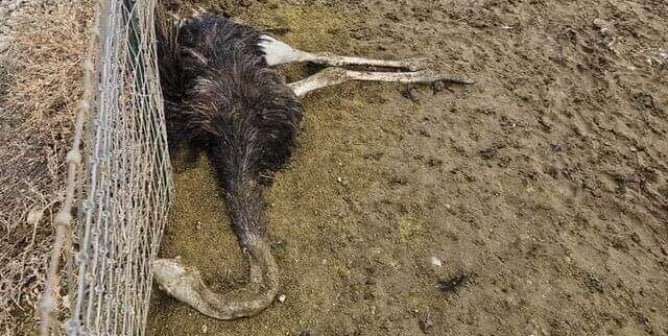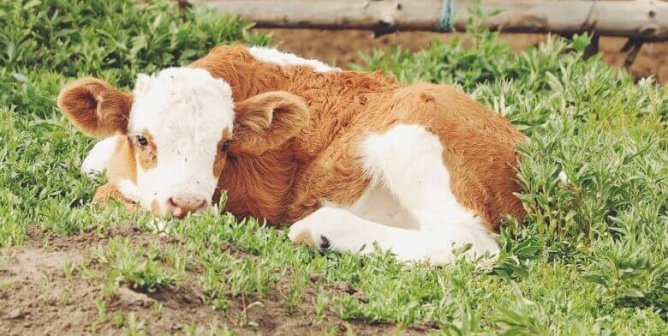Pigs: Intelligent Animals Suffering on Farms and in Slaughterhouses
Pigs “have the cognitive ability to be quite sophisticated. Even more so than dogs and certainly [more so than] three-year-olds,” says Dr. Donald Broom, a Cambridge University professor and a former scientific adviser to the Council of Europe.1 Pigs can play video games, and when given the choice, they have indicated temperature preferences in their surroundings.2
These facts should not come as a surprise to anyone who has spent time around these social, playful animals. Pigs, who can live into their teens, are protective of their young and form strong bonds with other pigs. Pigs are clean animals, but they do not sweat as humans do, so they prefer cool surfaces, such as mud, to help regulate their body temperature.4
Problems With Prisonlike Farms
Only pigs in movies spend their lives running across sprawling pastures and relaxing in the sun. On any given day in the U.S., there are more than 75 million pigs on factory farms, and 121 million are killed for food each year.5,6
The majority of mother pigs (sows)—who account for more 6 million of the pigs in the U.S.—spend most of their lives in individual “gestation” crates.7 These crates are about 7 feet long and 2 feet wide—too small to allow the animals even to turn around.8 After giving birth to piglets, sows are moved to “farrowing” crates, which are wide enough for them to lie down and nurse their babies but not big enough for them to turn around or build nests for their young.9
Piglets are separated from their mothers when they are as young as 10 days old.10 Once her piglets are gone, the sow is impregnated again, and the cycle continues for three or four years before she is slaughtered.11 This intensive confinement produces stress- and boredom-related behavior, such as chewing on cage bars.12
After they are taken from their mothers, piglets are confined to pens and barns over the span of about six months, fed until they weigh upwards of 280 lbs and are ready to be sold as meat.13 Every year in the U.S., millions of male piglets are castrated (usually without being given any painkillers) because consumers supposedly complain of “boar taint” in meat that comes from intact animals.14 Piglets are not castrated in the U.K. or Ireland, but the practice varies in the European Union from country to country.15
In extremely crowded conditions, piglets are prone to stress-related behavior such as cannibalism and tail-biting, so farmers often chop off piglets’ tails and use pliers to break off the ends of their teeth—without giving them any painkillers.16 For identification purposes, farmers also cut out chunks of the young animals’ ears.17
Please visit PETA.org for an inside look into a breeding facilty, where an undercover investigator witnessed the very beginning of the lives of animals who become bacon, pork chops, and sausages.
Transportation and Slaughter
Farms all over North America ship piglets (called “feeder pigs”) to Corn Belt states such as Illinois and Indiana for “growing” and “finishing.” When they are transported on trucks, piglets weighing up to 100 pounds are given no more than 2.4 square feet of space.18 One study confirmed that vibrations like those made by a moving truck are “very aversive” to pigs. When pigs “were trained to press a switch panel to stop for 30 seconds vibration and noise in a transport simulator … the animals worked very hard to get the 30 seconds of rest.”19
Once pigs reach “market weight,” the industry refers to them as “hogs” and they are sent to slaughter. The animals are shipped from all over the U.S. and Canada to slaughterhouses, most of which are in the Midwest. According to industry reports, more than 1 million pigs die en route to slaughter each year.20 No laws regulate the duration of transport, frequency of rest, or provision of food and water for the animals.21,22 Pigs tend to resist getting into the trailers, which can be made from converted school buses or multideck trucks with steep ramps, so workers use electric prods to move them along. No federal laws regulate the voltage or use of electric prods on pigs, and a study showed that when electric prods were used, pigs “vocalized, lost their balance, and tr[ied] to jump out of the loading area” and their “[h]eart rate and body temperature was significantly higher … when compared to pigs loaded using a hurdle [movable chute].”23
A typical slaughterhouse kills about 1,000 hogs per hour.24 The sheer number of animals killed makes it impossible for pigs’ deaths to be humane and painless. Because of improper stunning, many hogs are alive when they reach the scalding-hot water baths, which are intended to soften their skin and remove their hair.25 The U.S. Department of Agriculture documented 14 humane-slaughter violations at one processing plant, where inspectors found hogs who “were walking and squealing after being stunned [with a stun gun] as many as four times.”26 An industry report explains that “continuous pig squealing is a sign of … rough handling and excessive use of electric prods.” The report found that the pigs at one federally inspected slaughter plant squealed 100 percent of the time “because electric prods were used to force pigs to jump on top of each other.”27
Health Problems Caused by Eating Pork
Studies have shown that consumption of red meat can increase the risk of colorectal cancer, the third most common cancer in men and women, by as much as 30 percent.28 Researchers for the National Cancer Institute have found that eating meat raises men’s risk of prostate cancer, while a study from Yale University reports that meat-based diets can cause stomach cancer and esophageal cancer as well as lymphoma.29 A study of more than 90,000 women concluded that “frequent consumption of bacon, hot dogs, and sausage was … associated with an increased risk of diabetes.”30
Every year in the U.S., food poisoning sickens up to 48 million people and kills 3,000.31 Pork products are known carriers of foodborne pathogens, including E. coli, trichinella, listeria, salmonella, and pork tapeworms. One study of 256 pork samples taken from 36 different grocery stores found that up to 63 percent of the samples were contaminated with Staphylococcus aureus bacteria.32
Because crowding creates an environment conducive to the spread of disease, pigs on factory farms are fed antibiotics and sprayed with huge amounts of pesticides. The antibiotics and pesticides remain in their bodies and are passed along to people who eat them, creating serious health hazards for humans. Pigs and other factory-farmed animals are fed millions of pounds of antibiotics each year, and scientists believe that meat-eaters’ unwitting consumption of these drugs gives rise to strains of bacteria that are resistant to treatment.33
Environmental Hazards
Senior U.N. Food and Agriculture Organization official Henning Steinfeld reported that the meat industry is “one of the most significant contributors to today’s most serious environmental problems.”34
Each farmed pig produces about 10 pounds of manure per day.35 As a result, many tons of waste end up in giant pits, polluting the air and groundwater. According to the Environmental Protection Agency, agricultural runoff is the number one source of pollution in our waterways.36 In 2012, a North Carolina hog farm had to pay a $1.5 million in fines for violations of the Clean Water Act after illegally dumping waste into a stream leading to the Waccamaw River.37 And in the largest federally imposed pollution fine issued to date, pork producer Smithfield Foods paid $12.6 million for polluting the Pagan River with phosphorous-contaminated wastewater from its slaughterhouse.38
Raising animals for food also requires massive amounts of resources. Two-thirds of all agricultural land in the U.S. is used to raise animals for food or to grow grain to feed them.39 Pigs and other farmed animals are the primary consumers of water in the U.S.—a single pig may require up to 5 gallons of drinking water per day.40 In the “finishing” phase alone, during which pigs grow from 100 to 240 pounds, each hog consumes more than 500 pounds of grain, corn, and soybeans. This means that across the U.S., pigs eat tens of millions of tons of feed every year.41
What You Can Do
Stop factory-farming abuses by supporting legislation that abolishes intensive-confinement systems. McDonald’s, Chipolte and Target are just a couple of companies that have said they will stop buying from farms that use gestation crates.42 Smithfield Foods phased out the use of the crates in the US by the end of 2017 and plans to do the same for its international farms by 2022.43 In the meantime, voters in Florida, Arizona, California, Colorado, Maine, Massachusetts, Michigan, Ohio and Rhode Island have banned the use of gestation crates.44 In Canada, the crates are projected to be phased out of use by 2024, although the industry is pushing to delay that conversion until 2029.45,46
Stop giving your money to pig farms and slaughterhouses. Going vegan means eating for life— your life and animals’ lives. Visit PETA.org to order a free copy of PETA’s vegetarian/vegan starter kit.
References
1Cambridge Daily News, “New Slant on Chump Chops,” Cambridge Daily News, 29 Mar. 2002.
2Miguel Helft, “Pig Video Arcade Critiques Life in The Pen,” Wired, 6 Jun. 1997.
3America’s Test Kitchen Radio, “412: Pig Tales: A True Story of Smart Pigs, Dumb Farmers and The American Pork Industry,” WNYC, 17 Apr. 2015.
4Deborah Bracconier, “Wallowing in Mud Is More Than Just Temperature Control,” Phys.org, 2 May 2011.
5National Agricultural Statistics Service, “Quarterly Hogs and Pigs,” U.S. Department of Agriculture, 27 Sept. 2018.
6National Agricultural Statistics Service, “Livestock Slaughter 2017 Summary,” U.S. Department of Agriculture, April 2018.
7National Agricultural Statistics Service.
8David Jackson and Gary Marx, “Pork Producers Defend Gestation Crates, But Consumers Demand Change” The Chicago Tribune, 23 Aug. 2016.
9Ron Ketchem and Mark Rix, “Is Farrowing Crate Design a Constraint to Weaning Average?” National Hog Farmer, 10 June 2013.
10Graeme Taylor and Greg Roese, “Basic Pig Husbandry – The Weaner,” ThePigSite.com, 18 Apr. 2006.
11Tasha R. Gruhot et al., “An Economic Analysis of Sow Retention in A United States Breed-to-Wean System,” Journal of Swine Health and Production” 25(2017):238-246.
12MY Zang et al., “Effects of Confinement Duration and Parity on Stereotypic Behavioral and Physiological Responses of Pregnant Sows,” Physiology & Behavior, 179(2017):369-376.
13American Meat Science Association, “Pork Production: Farrow to Finish Process,” TheMeatWeEat.com, 9 Mar. 2017.
14Sam Brasch, “Is the GMO Debate Aimed at Pig Testicles? Modern Farmer, 20 Jan. 2015.
15“Progress Report: Castration of Pigs in the EU,” The Pig Site, 5 Dec. 2016.
16John C. Rea, “Care of Pigs from Farrowing to Weaning,” University of Missouri Extension, accessed 18 Nov. 2018.
17Ibid.
18Temple Grandin, “Welfare of Pigs During Transport Department of Animal Sciences, Colorado State University, Nov. 2014.
19A.J. Zanella and O. Duran, Pig Welfare During Loading and Transportation: A North American Perspective, I Conferência Virtual Internacional Sobre Qualidade de Carne Suína, 16 Nov. 2000.
20John Goihl, “Transport Losses of Market Hogs Studied Feedstuffs, 28 Jan. 2008.
21Dennis A. Shields and Kenneth H. Mathews Jr., “Interstate Livestock Movements U.S. Department of Agriculture, June 2003.
22Zanella and Duran.
23Ibid.
24Andrew Wasley et al., “Two Amputations A Week: The Cost of Working in A US Meat Plant,” The Guardian, 5 July 2018.
25Joby Warrick, “‘They Die Piece by Piece,’” The Washington Post, 10 Apr. 2001.
26Ibid.
27Temple Grandin, “2001 Restaurant Audits of Stunning and Handling in Federally Inspected Beef and Pork Slaughter Plants,” 2002 Meat Institute Animal Handling and Stunning Conference, Colorado State University: Department of Animal Sciences, 2002.
28Nuri Faruk Aykan, “Red Meat and Colorectal Cancer,” Oncology Reviews, 9(2015):288.
29R. Sinha et al., “Meat and Meat-Related Compounds and Risk of Prostate Cancer in a Large Prospective Cohort Study in the United States,” American Journal of Epidemiology, 1 Nov. 2009.
30M.B. Schulze et al., “Processed Meat Intake and Incidence of Type 2 Diabetes in Younger and Middle-Aged Women,” Diabetologia, 24 Oct. 2003.
31Centers for Disease Control and Prevention, “CDC Estimates of Foodborne Illness in the United States,” U.S. Department of Health and Human Services, 19 Aug. 2016.
32Ashley M. O’Brien et al., “MRSA in Conventional and Alternative Retail Pork Products” PLoS ONE 7 (2012).
33Timothy F. Landers, RN, CNP, PhD, et al., “A Review of Antibiotic Use in Food Animals: Perspective, Policy, and Potential,” Public Health Reports, 127(2012):4-22.
34U.N. News Service, “Rearing Cattle Produces More Greenhouse Gases Than Driving Cars, U.N. Report Warns” U.N. News Centre, 29 Nov. 2006.
35Beth Hoffman, “What The Pork? China, Pigs And Poop,” Forbes, 13 May 2014.
36Environmental Protection Agency, “Nonpoint Source: Agriculture,” Polluted Runoff: Nonpoint Source (NPS) Pollution, 18 Aug. 2017.
37Craig Jarvis, “Money from Hog Farm Prosecution Buys Land To Protect the Waccamaw River,” The News & Observer 31 Aug. 2018.
38David Bacon, “How US Policies Fueled Mexico’s Great Migration,” The Nation, 23 Jan. 2012.
39Daniel P. Bigelow and Allison Borchers, “Major Uses of Land in the United States, 2012,” U.S. Department of Agriculture, Aug. 2017.
40Theo van Kempen, “Whole Farm Water Use,” North Carolina State University Swine Extension, July 2003.
41American Meat Science Association.
42Associated Press, “Pig Abuse Is Just Part of The Problem on Pork Farms,” CBS News, 31 July 2018.
43Elisha Sauers, “Smithfield Foods Delivers on Decade-old Promise To Eliminate Pregnant Sow Stalls in US,” The Virginian Pilot, 23 Jan. 2018.
44Sauers.
45Jennifer Jackson, “How Do Canada’s Welfare Standards Compete Worldwide?” Farms.com, 9 May 2017.
46“Code Technical Panel, Five-Year Review, Summary Report Code of Practice for the Care and Handling of Pigs, Aug. 2020.


